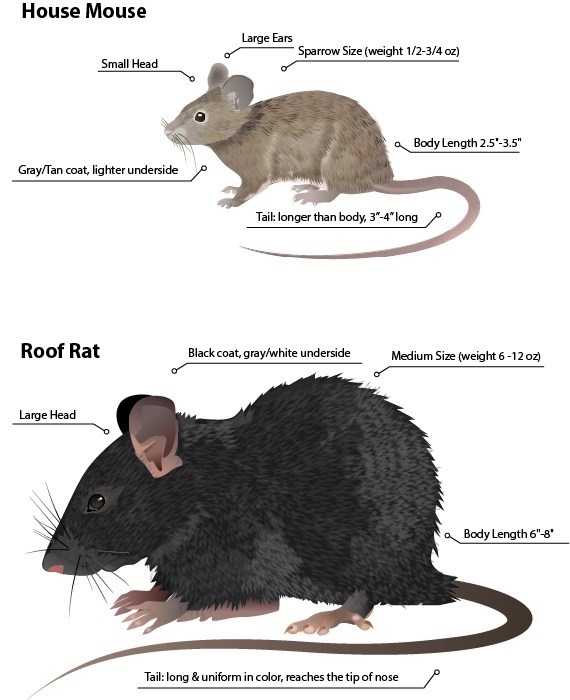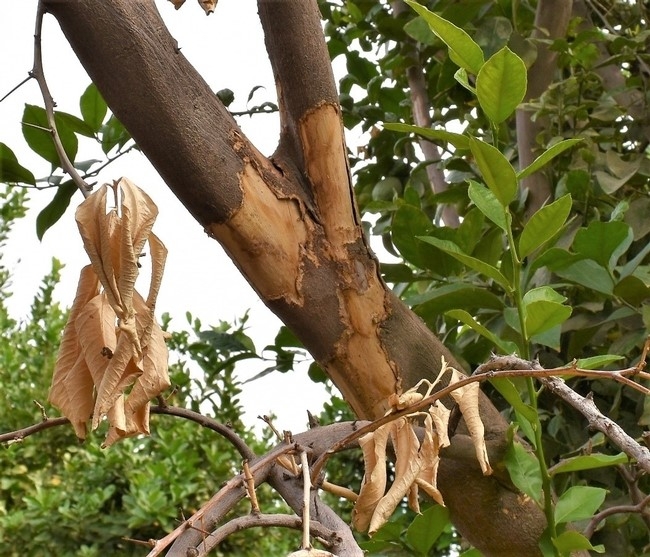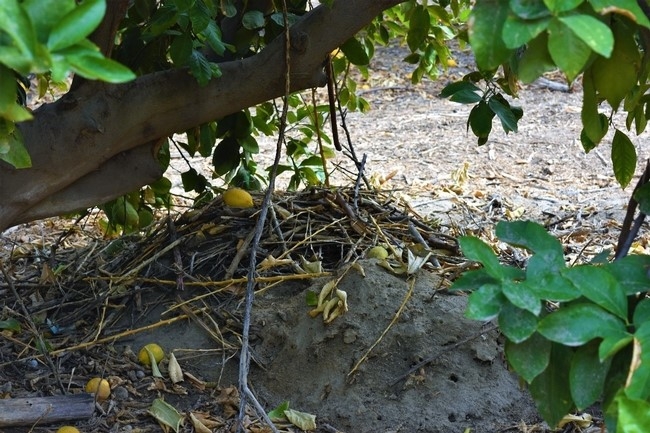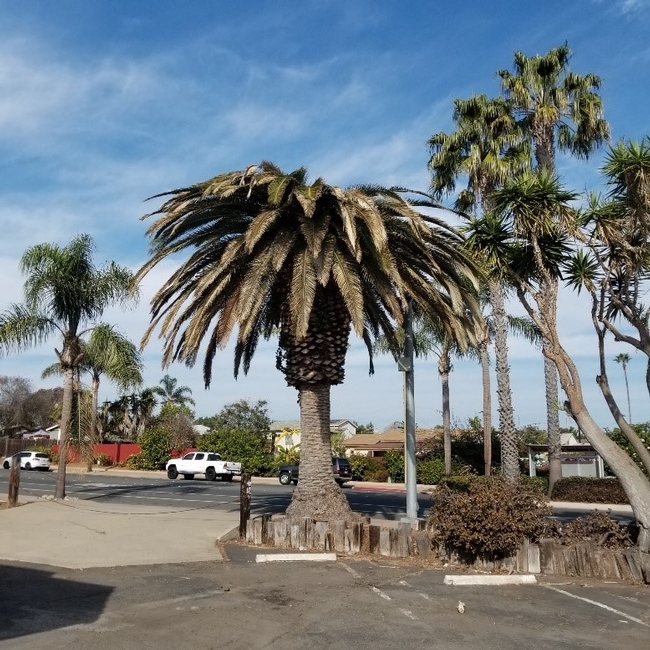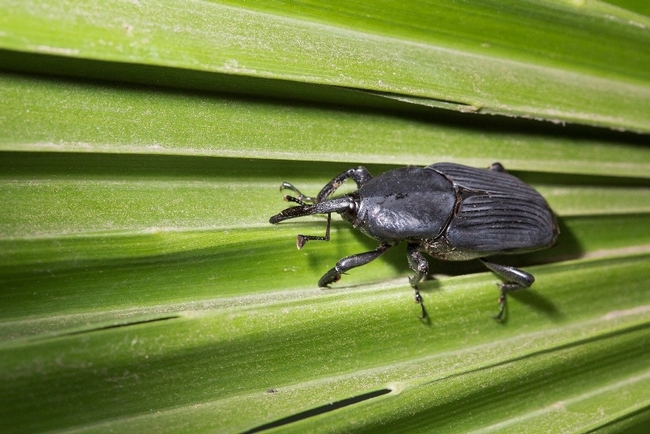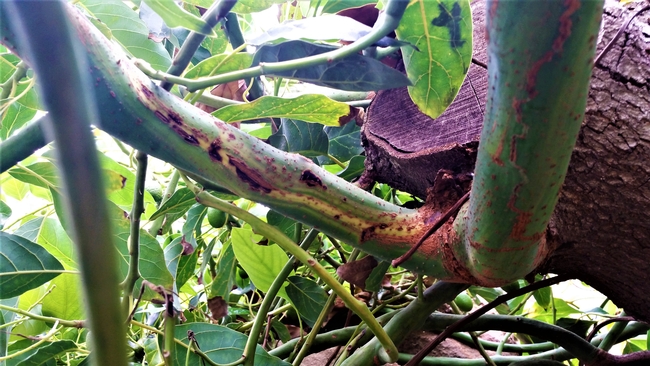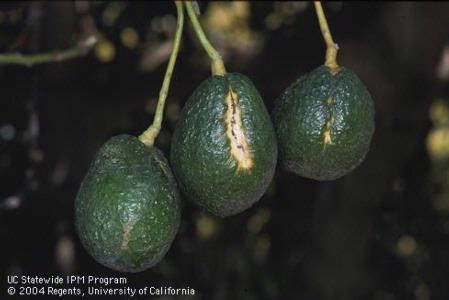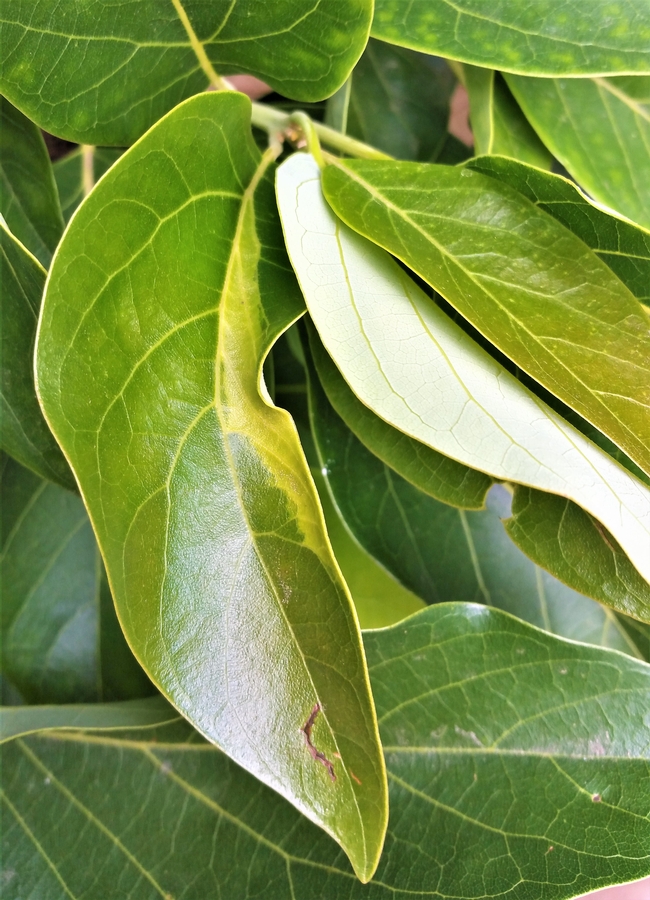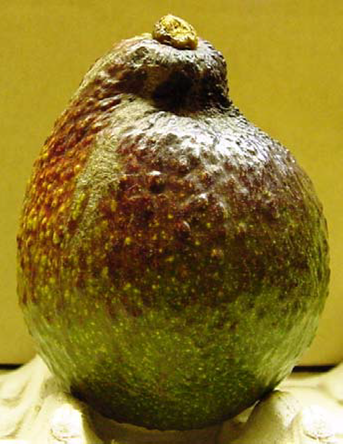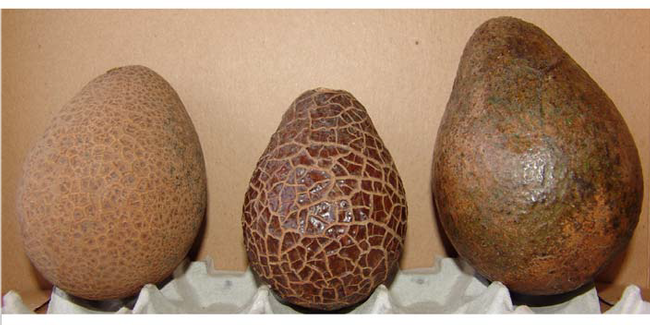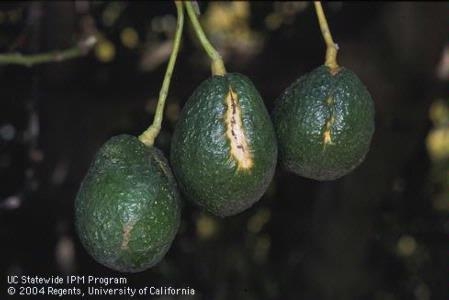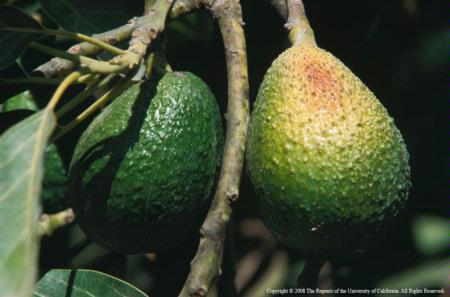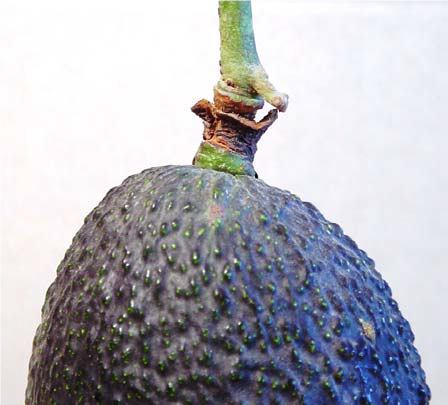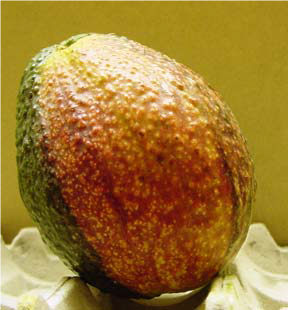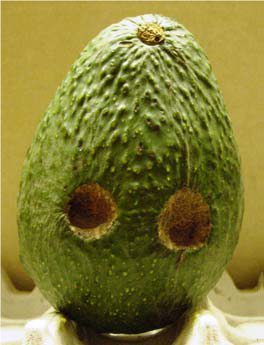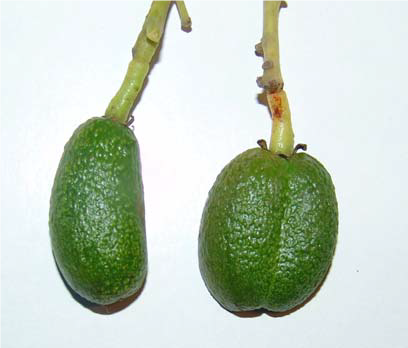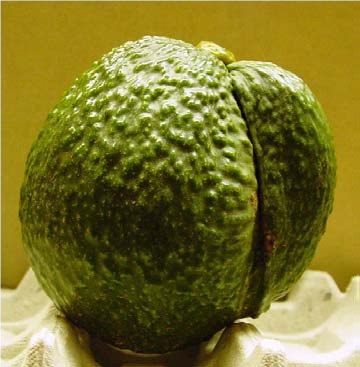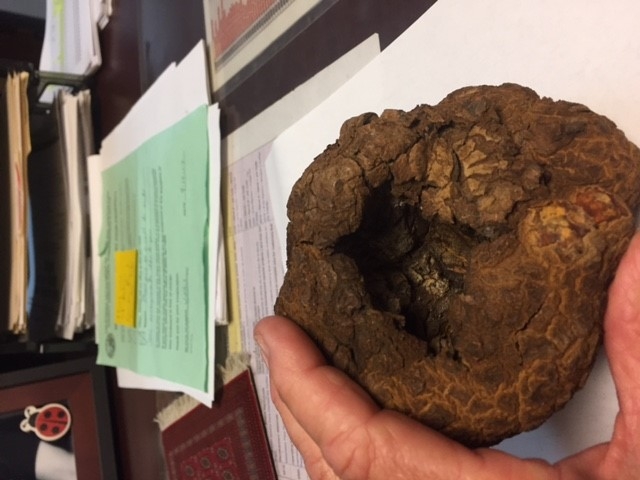
Posts Tagged: biotic
Ah, Rats!
The roof rat (Rattus rattus, also known as a citrus rat, fruit rat, black rat, or gray rat) is an introduced species of rat native to southern Asia. It was brought to America on the first ships to reach the New World. This is the same species that carried the bubonic plague around the world and is the reservoir host for murine typhus, which is a disease that is transmitted by fleas. This primarily nocturnal vertebrate is a pest in citrus, nut orchards and other tree crops. In citrus, it builds leaf and twig nests in trees or it can nest in debris piles, thick mulch pile on the ground, or in shallow burrows under the tree. In livestock feed yards and barns, roof rats often burrow and hide under feed bunks or in the hay bales. Adult roof rats range from 12-14 inches long (30-36cm) and weigh 5-10oz. (150-250g) (UC IPM 2017). The large, sleek rat has a pointed muzzle and hairless scale-covered tail that can be longer than the body and head combined.
DAMAGE
A rats gnawing can cause some serious damage to just about anything, electrical wires, wooden structures, and they tend to not be picky about which agriculture crop to invade. Roof rats often feed on citrus, avocados, and other fruits, sometimes leaving hollow fruit skins hanging on the tree. In tree crops, they can girdle limbs or stems, leading to mortality to part or all of a tree. After harvest, they damage fruit and nuts in bins by chewing them and leaving excrement. This can cause major esthetics damage to fruit and become a food safety issue. Since rats are active throughout the year, and mostly at night, this can be a challenge to growers and can become infestation because of their quick gestational period of 3 to 4 weeks.
MANAGEMENT
Cultural Control
Because roof rats are such good climbers, swimmers, and hitchhikers it is hard to completely exclude them from your grove or orchard. Fruit trees should be isolated, not touching fences, overhead wires, or the scaffolds or branches of other trees. Roof rats will run along fence stringer boards or support poles, phone and cable TV wires, and tree branches to reach your fruit tree. Lower branches of the tree should never touch the ground. Reducing shelter and nesting opportunity sites of rats is crucial. Eliminate debris and woodpiles and store materials neatly off the ground. Thin and separate non-crop vegetation around orchards, such as weeds and remove dead wood from fruit trees, especially in citrus and avocado (UC IPM 2017). A low-hanging skirt of drooping branches give the rats additional access routes and provides them with protective cover while feeding. It's best to prune tree skirts so that the ground under them is open and visible. This lack of cover makes the rats uncomfortable and more susceptible to predators such as snakes and birds of prey.
Sanitation is also an important component to an IPM program. Use or remove all fallen fruit, do not leave any fruit behind, as the roof rat is an opportunist and will take advantage of the mess left behind.
Monitoring and Treatment Decisions
According to the UC IPM guidelines, the use of elevated bait stations containing 0.005% diphacinone*-treated oats (sold at some county agricultural commissioner's offices) is highly effective at controlling roof rats in orchards. Secure bait in a bait station before placing in trees on limbs 6 feet or more above the ground. Placing the bait in a secure bait station will prevent bait from dropping to the ground and creating a hazard for non-target species. Bait can only be applied during the non-bearing season, so growers must take a proactive approach to managing problematic rat populations (UC IPM 2017).
Trapping
Rat-sized snap or wooden box traps placed in trees are also effective, although a more time-consuming control option. Do not use glue board traps outdoors, as birds, lizards, and other non-target wildlife may be trapped. Rats are wary, tending to avoid baits and traps for at least a few days after their initial placement. Fasten traps to limbs and bait them with fruit or nut meats, but do not set the traps until after bait is readily eaten. Be aware that certain types of rat baits for use inside buildings (such as sticky traps) are not labeled for use outdoors in orchards; these are hazardous to wildlife and should not be used.
Preventative care, sanitation and scouting for rat's nests or damage is the easiest way to stop a problem before it becomes a problem. For more information regarding the roof rat, please visit the UC IPM website: http://ipm.ucanr.edu/PMG/PESTNOTES/pn74106.html.
Baiting *Be sure to identify the species of rat present to avoid killing non-target or protected species.*
Palm Weevil Threat to Palm Trees
Date growers in the California deserts have many insects to worry about such as carob moth, hibiscus mealybug, and giant palm borer. Now the industry is under threat from another potential pest, the highly damaging and invasive South American palm weevil (SAPW) (Rhynchophorus palmarum). It was first identified by county and state agriculture officials in 2011 in San Ysidro in San Diego. They made the discovery while looking for a closely related palm weevil, R. vulneratus (originally mis-identified as the notorious red palm weevil, R. ferrugineus), which was found in Laguna Beach and declared eradicated in Jan. 2015.SAPW has been reported on at least 35 plant species in 12 families and is especially economically important on plantation crops such as oil and ornamental palms of which date palm, Phoenix dactylifera, is a recorded host (CABI 2016; Dean 1979; Esser and Meredith 1987). SAPW has killed hundreds of Canary Island date palms (P. canariensis) in Tijuana and parts of San Diego County. These large urban infestations pose a significant risk to the multi-million dollar date palm industries (edible fruit and ornamentals) in the Coachella Valley. Losses of ornamental Canary Island date palms in San Diego County, are probably significant and likely now reaching millions of dollars in killed palms, reduced aesthetics, and increase removal costs.
SAPW has a long rostrum (this is the beetle's snout) and is large often up to 1 ½ inches to 2 inches in length (CDFA 2018). SAPW is now California's biggest weevil species! Inside the palm crown, weevil larvae feed on the meristematic tissue and it is this feeding that kills the palm crown which results in palm death. Larvae pupate inside 3-inch cocoons made of palm fibers. The pupal stage typically lasts two to three weeks. Adult weevils emerge from these protective cocoons, mate, and they are capable of flying significant distances, perhaps as far as 15 miles in a single day, to find new palm hosts. Female weevils use their snout to chew holes in the apical regions of the palm and they lay eggs in these holes. Larvae that hatch from eggs burrow into the palm crown and feed turning the meristem tissue in a fermenting “mash”. Feeding wounds that result in fermenting damage in association with aggregation pheromone released by male weevils create a highly attractive airborne cocktail of odors that weevils fly too. Adult weevils can live for at least 40 days, often longer (CDFA, 2018).
A single infected palm can result in the production of hundreds of weevils and detection of weevil infested palms at the early stages of attack can be difficult to identify because larvae live inside their host trees. The first obvious symptom of attack is a crown that is starting to collapse. Unless palms are treated within systemic insecticides at the early stages of attack, infested palms will ultimately die in as little as 2-3 months once visual symptoms become apparent.
In addition to direct physical damage SAPW inflict via feeding, it is a primary vector of the nematode that causes red ring disease (RRD), a fatal wilt disease of palms. Fortunately, RRD has not yet been detected in SAPWs or palms attacked in San Diego (Hoddle et. al. 2016). Removal of infected trees is necessary not only to remove breeding weevil populations from the environment, but also to minimize risk of harm to people, pets, and property from crown and frond drop.
More information on the SAPW invasion and to report suspect palms please visit this website: http://cisr.ucr.edu/palmarum.html
What Caused that Symptom???
Diseases, disorders and other plant problems are critical concerns for the wholesale nursery. These include biotic problems — caused by living organisms such as pathogens, nematodes, and insects and other arthropods — as well as abiotic problems — caused by factors such as temperature and moisture extremes, mechanical damage, chemicals,
nutrient deficiencies or excesses, salt damage and other environmental factors. Many plant problems, especially biotic problems, if not recognized and controlled early in their development, can result in significant economic damage for the producer. Therefore, timely and accurate diagnoses are required so that appropriate pest and disease
management options and other corrective measures can be implemented.
Definition of Plant Diagnosis and Steps
Diagnosis is the science and art of identifying the agent or cause of the problem under investigation. When one renders a diagnosis, one has collected all available information, clues and observations and then arrives at an informed conclusion as to the causal factor(s). Hence, plant problem diagnosis is an investigative, problem-solving process that involves the following steps:
- Ask and answer the appropriate questions to define the problem and
obtain information that is relevant to the case under investigation.
- Conduct a detailed, thorough examination of the plants and production areas.
- Use appropriate field diagnostic kits and lab tests to obtain clinical information on possible causal agents and factors.
- Compile all the collected information and consult additional resources and references.
- Finally, make an informed diagnosis.
Throughout this process compile all notes, observations, maps, laboratory results, photographs and other information. This compilation will be the information base for the present diagnosis and can also be a useful resource for future diagnostic cases. Keep an open mind as the information is analyzed and do not make unwarranted assumptions.
Distinguishing Abiotic and Biotic Problems
The first step is to determine whether the problem is caused by an infectious agent, and this can be difficult. Plant symptoms caused by biotic factors such as infectious diseases and arthropod pests are oftensimilar to damage caused by other factors. Leaf spots, chlorosis, blights, deformities, defoliation, wilting, stunting and plant death can
be common symptoms of both biotic and abiotic problems; therefore, the presence of these symptoms does not necessarily mean the problem is a disease. Some general guidelines for distinguishing abiotic and biotic
problems follow and are summarized in table 1.
Table 1 DISTINGUISHING ABIOTIC AND BIOTIC PROBLEMS |
||
Characteristics |
Abiotic |
Biotic |
Hosts |
often affects several species or plants of various ages |
often affects one species or cultivar of the same age |
Pattern of plant symptoms |
often related to environmental or physical factors or cultural practices; may be regular or uniform |
often initially observed in random or irregular locations |
Rate of symptom development |
relatively uniform, extent of damage appears similar among plants |
relatively uneven, time of appearance and damage severity varies among affected plants |
Signs |
no evidence of the kinds of pests or pathogens known to cause the current symptoms |
presence of insects, mites, |
Spread |
is not infectious, is not progressive, commonly caused by one incident and does not spread |
infectious, spreads on host over time if environmental conditions are suitable |
Recurrence |
possibly previously associated with current or prior environmental conditions or cultural practices |
possibly caused by pests that |
Adapted from Table 18, ANR Pub 3420 |
||
Biotic problems. Identifying biotic problems is sometimes facilitated if signs of a pathogen, primarily the growth of a fungus, are present. The most obvious examples of such signs are the mycelium and spores produced by rusts and powdery and downy mildews. However, in other cases nonpathogenic fungican grow on top of damaged plant tissues and appear to be signs of a pathogen, resulting in possible misdiagnoses.
Biotic problems often affect one species or cultivar of the same age and typically are initially observed in random or irregular locations; symptoms appear at varying times, and severity varies among affected plants. Biotic problems are infectious, spreading when environmental conditions are favorable, and may be associated with pests that have affected the crop. This infectious aspect is important, as biotic diseases will many times be progressive and continue to affect
additional tissues and more plants.
Abiotic problems. In contrast to biotic factors, abiotic problems often affect several species or plants of various ages; typically, damage is relatively uniform, doesn't spread and is often not progressive. Abiotic problems are not associated with pests. They are often caused by a single incident and are related to environmental or physical factors or cultural practices. Once the responsible factor has dissipated and is no longer affecting the plant, the plant may grow out of the problem and develop new, normal appearing foliage.
Diagnosing Biotic Problems
Infectious diseases. To confirm if a problem is caused by a pathogenic fungus, bacterium, nematode, or virus, it is often necessary to have symptomatic tissues analyzed by a trained horticulturalist or plant pathologist. Such experts will attempt to microscopically observe the agent and recover it, if culturable, through isolation procedures. Lab analysis is particularly important to determine if multiple pathogens are infecting the plant. A downside is that obtaining a diagnosis from lab analysis is not a fast process. However, quick test kits (fig. 1A) are available that can be used to rapidly identify many common diseases in the field.
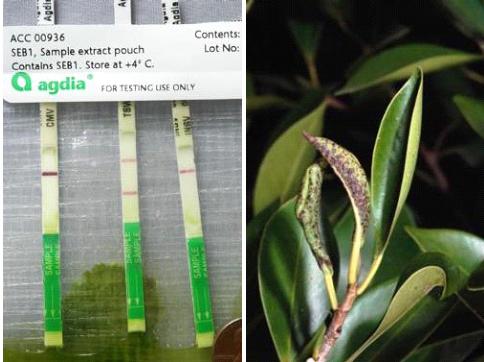
A B
Fig.1. Diagnosing biotic
problems. Plant pathogens can sometimes be rapidly diagnosed using
commercially available quick tests, such as these test strips for
viruses (A). Arthropod pests such as Cuban laurel thrips (shown here on Ficus) cause feeding damage, which can help in pest identification (B). Photos: S.T. Koike (A), J. K. Clark (B).
It is worthwhile to emphasize that diagnosing plant diseases requirescareful examination of the entire plant specimen. Symptoms on leaves, stems, or other above ground plant parts might lead one to suspect that afoliar pathogen is involved. However, these symptoms could also resultif the roots are diseased. Therefore, it is important to conduct a
complete examination of the symptomatic plant.
Because biotic diseases are caused by living microorganisms, the collecting and handling of samples is particularly critical. Samples that are stored for too long a time after collecting or that are allowedto dry out or become hot (if left inside a vehicle, for example) will sometimes cause the pathogen in the sample to die, making pathogen recovery and identification impossible. Plants that have been diseased for a long time and that are in the late stages of disease development will often be colonized by nonpathogenic saprophytic organisms. If these tissues are collected, it will be difficult to recover the primarypathogen of concern because of the presence of these secondary decay organisms. Root samples should be collected carefully as diseased rootsare sometimes difficult to dig out of the potting mix or soil, are
usually colonized by the pathogen as well as secondary agents, and are very sensitive to high temperatures and drying conditions.
Arthropod and other invertebrate pests. Insects,mites, slugs and snails cause damage while feeding on the plant (fig. 1B). Feeding damage is usually associated by the type of feeding characteristics and mouthparts of the insect or pest. For example, mites and insects such as whiteflies, aphids and mealybugs have tubular sucking mouthparts that suck plant fluids, causing buds, leaves, or flowers to discolor, distort, wilt, or drop. Thrips have rasping mouthparts that result in dried out, bleached plant tissue. Caterpillars, weevils, snails and slugs have chewing mouthparts that
make holes and cuts in foliage or flowers. They can also prune plant parts and sometimes consume entire plants.
If present, these pests are visible with the naked eye, a 10 X hand lens, or stereomicroscope, all depending upon their size. An assessment of whether the identified arthropod or invertebrate matches the plant damage it is associated with must be determined. Sometimes the identified arthropod or invertebrate may not be the sole problem or
could, in fact, be a beneficial organism or insignificant pest.
Aphids, whiteflies, thrips, leafhoppers and some other insects that suck plant juices may vector pathogens such as viruses and phytoplasmas (and to a lesser extent fungi and bacteria). They can feed on infected plants, acquire the pathogen, feed on healthy host plants and transmit the pathogen to the new host. The insects do not necessarily have to bepresent in large numbers to cause a significant disease outbreak. The insect vectors are not always present at the same time the disease symptoms are being expressed.
The excrement and byproducts from these pests can also provide clues that the pests have been or are actively present. Caterpillars and other chewing pests produce dark excrement or droppings. Greenhouse thrips and plant bugs produce dark, watery, or varnish-like droppings onfoliage. Aphids, whiteflies, soft scales, and some other sap-sucking insects excrete excess plant fluids as honeydew, a sticky sap, which provides a medium for the growth of sooty mold.
Diagnosing Abiotic Problems
Nutrient deficiencies and toxicities. Nutrientdeficiencies and toxicities reduce shoot growth and leaf size, cause leaf chlorosis (fig.2A), necrosis and dieback of plant parts. However, nutrient deficiencies cannot be reliably diagnosed on the basis of symptoms alone because numerous other plant problems can produce similarsymptoms. There are general symptoms that can be expressed by deficiencies of nutrients but usually leaf and/or soil samples are
needed to confirm the problem.
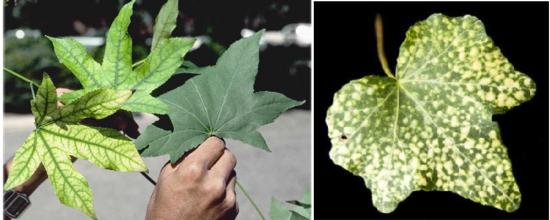
A B
Fig. 2. Examples of abiotic problems. Iron deficiency on sweet gum (Liquidambar styracifolia) showing interveinal chlorosis (A). Chorotic spots on Hedera caused by a miticide application at a higher dosage rate than specified on the pesticide label (B). Photos: E. Martin (A), S. A. Tjosvold (B).
Herbicide, insecticide and fungicide phytotoxicity. Herbicidesused to control weeds in crops or in non-cropped areas sometimes injureornamental crops when they are not used in accordance with label instructions. Examples include when an herbicide is used in or around sensitive non-target crops, when an herbicide rate is increased above tolerable limits, or when an applicator makes a careless application. By understanding the mode of action of the herbicide, one can determine if the symptom fits an herbicide application. Herbicide detection in affected plants is possible with the help of a specialized laboratory but the analysis can be expensive. To minimize the cost of testing, the laboratory will need to know the suspected herbicide or its chemical group to narrow the analysis. Pesticides and fungicides occasionally cause obvious plant damage.
Symptoms can vary widely. Generally, flower petals are more susceptible to damage from pesticide applications than are leaves. The younger and more tender the leaves the more susceptible they are to pesticide applications. Hot weather can exacerbate the damage the chemicals cause. Pesticides that have systemic action can have a more profound effect. Some active ingredients can adversely affect the photosynthetic mechanism or other physiological processes and can resulti n a general leaf chlorosis, interveinal chlorosis, leaf curling and stunting. Emulsifiable concentrate (EC) formulations, soaps and oils can adversely affect the waxy surface layer that protects the leaf from desiccation. Applications with these products can result in the loss ofthe shiny appearance of a leaf, leaf spotting and necrosis. Pesticidesapplied as soil drenches can cause poor germination, seedling death, or
distorted plant growth.
Check label precautions against use on certain species. Make sure thepesticide is not applied more frequently or at a higher rate (fig. 2B) than recommended, or that the pesticide is not mixed with incompatible pesticides. When in doubt as to whether the plant species is sensitive to the pesticide, spray a few plants and observe them for several days to a week for any signs of damage before spraying any more of the plants.
Physiological and Genetic Disorders
There are numerous disorders that can occur because of environmental extremes — too much or too little of an environmental element such as light, temperature, water, or wind. Sunburn is damage to foliage and other herbaceous plant parts caused by a combination of too much light and heat and insufficient moisture. A yellow or brown area develops on foliage, which then dies beginning in areas between the veins. Sunscaldis damage to bark caused by excessive light or heat. Damaged bark becomes cracked and sunken. Frost damage causes shoots, buds and
flowers to curl, turn brown or black and die. Hailstones injure leaves,twigs, and in serious cases even the bark. Chilling damage in sensitive plants can cause wilting of foliage and flowers and development of dark water-soaked spots on leaves that can eventually turn light brown or bleached, and die. Physical and mechanical injury can occur when plants are mishandled during transport or routine cultural practices. Wounds might serve as entry sites for plant pathogens and can attract boring insects to woody stems.
In closed environments such as greenhouses and nursery storage areas,plants can be exposed to toxic levels of ethylene gas. Sources of ethylene include improperly functioning or unvented greenhouse heaters; exhaust from engines of forklifts and vehicles; cigarette smoke; damaged, decaying, or dying plants; and ripe or decaying fruit. Toxic levels of ethylene gas can cause premature abscission of flower buds, petals (fig. 3) and leaves. Other symptoms include wilted flowers, chlorosis, twisted growth or downward bending of stems and leaves and undersized or narrow leaves.
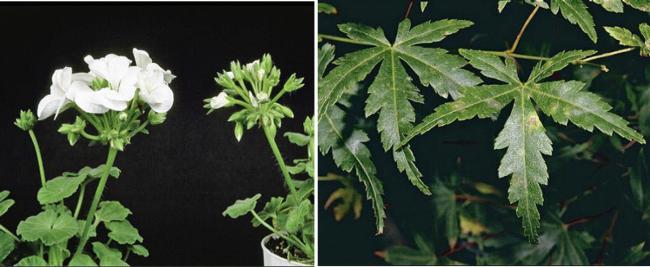
A B
Fig. 3. Poor air quality can
lead to physiological disorders. Shattering (petal drop) on geranium was
caused by plant exposure to low levels of ethylene in the greenhouse or
during postharvest storage (A). Yellowish and brownish patches on
Japanese maple leaves are damage caused by ozone (B), an outdoor air
pollutant. Photos: J. K. Clark.
Outdoors, exposure of nursery plants to air pollutant gases such as ozone (fig. 3), carbon monoxide, nitrous oxides and sulfur dioxide can cause damage. Typical symptoms vary widely, but include slow growth anddiscolored, dying, or prematurely dropping foliage. Damage is often found where plants are located near sources of polluted air such as near
freeways or industries or where weather and topography concentrate the pollutants.
Sometimes plants or plant shoots exhibit an unusual and sudden changeof color producing discrete markings of variegation. For example, a plant with entirely green leaves suddenly produces a shoot that has leaves with edges lacking green pigment, stripes, or blotches. A new shoot such as this is probably a chimera (fig. 4). It is produced when a genetic mutation occurs in a specific region of the growing tip resulting in a section with genetically different cells. The ostensible result of the genetic change is dependent on the arrangement of the genetically different cells in the shoot tip and their expression. This can lead to sometimes bizarre variegation forms or sometimes forms thatare quite desirable. Sometimes variegation can be caused by viruses. Viruses usually cause non-uniform chlorosis, such as mosaics, while
chimeras usually produce patterned forms such as variegation of color onleaf margins, stripes, or complete loss of pigment. Some viroids may also cause bleaching of pigments in leaves; such symptoms, however, are generally produced throughout the plant and are not restricted to a single shoot. Some nutrient disorders can cause variegation but these disorders usually do not arise from a specific shoot as with chimeras.
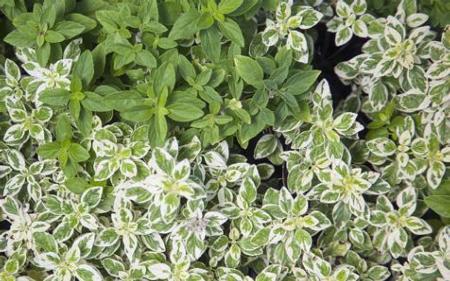
Fig. 4. Genetic disorder.
Growing points with variegated leaves can sometimes arise spontaneously
from some species such as this Origanum. Genetic variants such as this are sometimes confused with plants with virus disease or nutrient deficiency symptoms. Photo: S. A. Tjosvold.
Steve Tjosvold is Environmental Horticulture Advisor and
Steve Koike is Plant Pathology Farm Advisor, UC Cooperative Extension,
Santa Cruz and Monterey counties.
This article was condensed from: Diagnosing Plant
Problems, Chapter 11. In Newman, J. (ed) Container Nursery Production
and Business Management. Univ. of Calif. Agric. and Nat. Resources.
Publication 3540. Richmond, CA.
References
Boxer P, Sandmann G. 1989. Target sites of herbicide action. Boca Raton, FL: CRC Press.
Costello L, Perry E, Matheny N, Henry M, Geisel P. 2003. Abiotic
disorders of landscape plants: A diagnostic guide. Oakland: University
of California Division of Agriculture and Natural Resources Publication
3420.
Derr JF, Appleton BL. 1988. Herbicide injury to trees and shrubs: A
pictorial guide to symptom diagnosis. Virginia Beach, VA: Blue Crab
Press.
Dreistadt SH. 2001. Integrated pest management for floriculture and
nurseries. Oakland: University of California Division of Agriculture and
Natural Resources Publication 3402.
Eagle, DJ. 1981. Diagnosis of herbicide damage to crops. New York, NY: Chemical Publishing Co.
Grogan RG. 1981. The science and art of plant disease diagnosis. Annual Review of Phytopathology 19:333–351.
Ratzinger EJ, Mallory-Smith C. 1997. Classification of herbicides by
the site of action for weed resistance management strategies. Weed
Technology 11:384–393.
Schubert TS, Breman LL. 1988. Basic concepts of plant disease and how
to collect a sample for disease diagnosis. Plant Pathology Circular No.
307. Florida Department of Agriculture and Consumer Services, Plant
Pathology Circular No. 307.
Sharma MP. 1986. Recognizing herbicide action and injury. Alberta Environmental Centre, Alberta Agriculture. Agdex 641–647.
Shurtleff MC, Averre CW. 1997. The plant disease clinic and field
diagnosis of abiotic diseases. St. Paul, MN: American Phytopathological
Society Press.
Stewart TM, Galea VJ. 2006. Approaches to training practitioners in
the art and science of plant disease diagnosis. Plant Disease
90:539–547.
Tickes B, Cudney D, and Elmore C. 1996. Herbicide injury symptoms.
Tucson, AZ: University of Arizona Cooperative Extension Publication No.
195021.
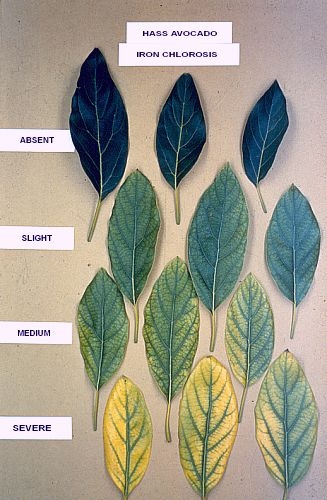
avocado chlorosis
Let’s talk about Avocado Sunblotch Viroid
Photo: Sun Blotch Branch
Sun-blotch, a viroid disease affecting the avocado, was observed as early as 1914 in Southern California. Sun-blotch is widespread in California, and likely to be found in all districts where avocados are being grown. The main counties in which the disease is found are San Diego, Ventura, Los Angeles, Orange, Riverside, and Santa Barbara.
Symptom's and signs
Sunblotch causes a wide variety of symptoms or may exhibit no symptoms in some hosts. The rate of spread of sunblotch virus appears to be extremely slow due to improved cultural practices in the nursery and field, and the apparent absence of an insect vector. Symptoms of sunblotch include necrotic, red, yellow, or white discolorations on fruit, often in depressions or scars in the fruit surface. Twigs can develop narrow, necrotic, red or yellow streaks on their surface or in shallow lengthwise indentations along the twig. Leaves may have white or yellowish variegated areas and be deformed, but leaf symptoms are uncommon. Rectangular cracking and checking of the bark, called "alligator bark," often occurs on the trunk and larger branches. Infected trees may be stunted and have a disproportionate amount of horizontal growth or sprawling lateral low limbs. Trees with visible sunblotch symptoms often have reduced yields. Infected trees can also be symptomless, although large reductions in yield of previously vigorous trees may indicate the presence of the viroid in otherwise symptomless carriers.
Photo: Sunblotch fruit
Sunblotch is caused by dozens of variants of submicroscopic particles of genetic material (viroids, smaller than a virus with no protein coat and only nucleic acid) that alter development and growth of infected plants. Sunblotch viroid can move systemically within avocado, and it persists in host tissues. Trees that do not show symptoms even though the viroid is present are known as "symptomless carriers." Nearly all cuttings and seed from symptomless carriers will be infected with viroid. However, seedlings from symptomless carriers do not show symptoms of sunblotch when they are used as rootstocks, but the disease often appears on scions grafted to them. Conversely, most seed from trees with symptoms are not infected, and budwood and shoot cuttings from sunblotch leaf symptomatic trees often do not contain viroid. [BF1] The viroid is transmitted in pollen, but pollen only infects the fruit and seed produced from it. Unless a tree is infected by grafting or some way other than through pollen, there will be no viroid in budwood, root grafts, and shoot cuttings from that tree. [BF2] Transmission of the viroid most often occurs during grafting by using infected budwood or rootstock seedlings from infected trees with or without symptoms. Natural root-to-root grafts are important in transmitting sunblotch in groves. Mechanical transmission through wounds caused by contaminated harvest clippers, pruning tools, and injection equipment can also be important if infected trees are in the grove. [BF3] Spread via pollen from an infected tree to the flower ovule of a noninfected avocado, resulting in infected seed, can cause fruit to be culled, but does not further spread the disease unless seed is propagated. There is no evidence of insect transmission.
Management
Nursery
Careful propagation of nursery stock to eliminate viroid has greatly reduced sunblotch to a relatively minor disease. However, ongoing monitoring and management is required in nurseries and established groves. Sunblotch can be easily overlooked, and there are many ways that trees can become infected. Look for diseases and disease-promoting conditions regularly throughout the grove. In the nursery, carefully select disease-free scions and seed sources. Use stringent sanitation and frequent disinfection to avoid spreading pathogens. Periodically confirm that propagation sources are disease-free (indexing) by grafting propagative source material to young Mexican seedlings and observing leaves and twigs for sunblotch symptoms, or by performing a genetic test. Plant only indexed nursery stock that is registered as disease-free.
Field
Promptly remove symptomatic trees from the grove and chemically kill the stumps. Do not retain infected, symptomless trees just because yield does not seem to be affected; symptomless carriers are a highly infective source that can dramatically reduce yield on other trees. If only fruit and seed are infected (from infected pollen), it may not be necessary to remove that tree if indexing indicates the rest of the tree is not infected. However, trees with only fruit and seed infection indicate that other infected (possibly symptomless) trees nearby need to be indexed or removed. The danger of spreading viroid increases in established orchards where mature trees are pruned to reduce tree size and restimulate or maintain fruit production. Severe pruning of symptomless carriers, and perhaps other severe causes of tree stress, are suspected of causing viroid to become active in the new growth, inducing previously symptomless trees to exhibit symptoms. Disinfect pruning tools, harvest clippers, and injection equipment before beginning work on a new tree. Scrubbing tools clean and then soaking them in a 1.5% sodium hypochlorite solution is effective. Growers must use a registered disinfectant and follow label directions.
Photo: Sunblotch leaf
As sunblotch is systematic in the avocado tree, it can exist in the roots as well as the above-ground parts. Thus, it might be transmitted through natural root graftage between a healthy and diseased tree. It is known that tree roots will sometimes become forced together in some manner until finally a natural root graft has taken place. The natural grafting between roots of trees has been attributed to a number of causes, some of which are as follows: (1) Roots growing in a shallow soil underlaid by a hardpan when crowded for growing space will sometimes become grafted together. (2) Two roots growing between two rocks or other barriers when wedged together tightly may form a graft. (3) Roots from mature avocado trees which are planted close together in a grove may, if crowded for growing space, form a graft. It is believed, through evidence existing in certain avocado orchards, that sun-blotch disease has infected healthy trees through natural root graftage.
Photo: Sun Blotch branch with salt-affected leaves 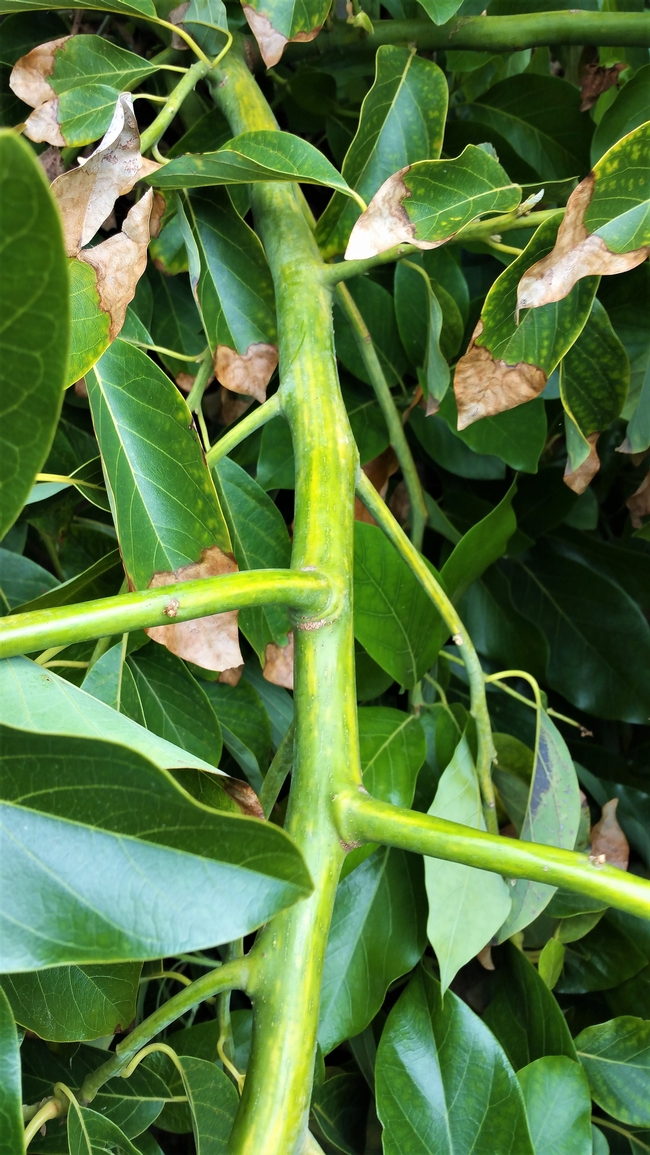
Crazy Avocado Fruit
Avocado harvest time and the growers are in the orchard checking things out a little more closely and to see what is going into the bins…..and they see some unusual shaped fruit. Here's what's been popping up and some possible explanations.
Crick-side - First described by Dr. J. Eliot Coit as kink-neck and later by Horne (1931) as kink-side. Finally, the name crick-side (Horne, 1934) was adopted. It is characterized by a definite depression on one side between the stem end and the larger portion of the fruit causing a distortion. In some cases, the area of depression turns black and the fruit drops. In other cases, the fruit grows and matures but the distortion remains. Crick-side is usually found on trees carrying a heavy load of fruit. It has been suggested that high temperatures or temporary water-stress may relate to the occurrence of crick-side, but no definite determination as to its cause has been made.
Carapace Spot - First described by Horne (1929), the name carapace-spot was chosen because of the resemblance to a turtles' back. This external blemish is corky and usually cracked into somewhat regular, angular divisions. The flesh under the carapace spot is undamaged, but exterior appearance is such that the fruit is reduced in grade. Slight rubbing or brushing of tender young fruit on leaves or stems appears to cause this corky growth to start. Fruit on trees exposed to strong winds are more apt to develop the trouble. Windbreaks should reduce injury in windy areas.
Photo: Avocado thrips damage, carapace damage and greenhouse thrips damage.
Sunblotch - This is a viroid that can affect fruit, leaves, and stems with a yellow or reddish streaking, cause a compacted growth and willowy growth habit. The streaking in the fruit is usually depressed and doesn't extend the length of the body.
Sunburn - Fruit exposed to full sun may be injured by sunburn. This occurs when trees defoliate, or partially defoliate, from any of several causes, leaving the fruit exposed. It is normally most severe on fruit on the south and southwest portion of the tree. Sunburn shows as a pale yellowish area on the exposed side of the fruit. Often the center of this area turns brown to black and may wither.
Ring Neck - This trouble has been observed occasionally, particularly with Hass. The cause is unknown but is believed to be related to soil-plant water deficiency at a critical time. A ring of tissue on the pedicel just above the attachment to the fruit dies, turns black and peels off. If only superficial, the fruit remains on the tree. Growth may be retarded because the restriction impedes movement of nutrients and water outward to the fruit. Most severe in humid coastal areas.
Embossment - Occasionally, and particularly on Fuertes, a section of the surface will be raised slightly or be a darker or lighter color. This is referred to as a sectional chimera or genetic mutation.
Healed over damage - if fruit has mild damage that allows it to heal over (remember avocado fruit expand by cell multiplication not enlargement), then a scar is left, such as this likely amorbia feeding
Cuke - As in cucumber but not a squash. These are seedless fruit that can most often be seen from a fruit set in cooler weather or due to some hormonal stimulus. We don't know the reason, but seems to occur more commonly along the coast.
Double Fruit - In some instances there may be a normal shaped fruit with a single cuke attached ot in some cases there is a double ovary and two fruit are attached.
Woody Avocados - For some unknown reason, avocado fruit will form into a grotesque woody structure hardly resembling an avocado. The cause is genetic and non-transmissible.
Sources: R.G. Platt - California Avocado Society Yearbook 1972-73 and Reuben Hofshi and M.L. Arpaia Yearbook 2002.

